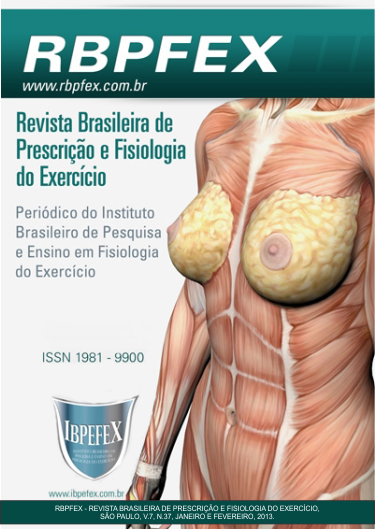Comparative analysis of body composition and physical fitness among students school athletes and non-athletes of infant female handball category winners of regional high Sertão do Pajeú-PE
Abstract
This paper aims to collect anthropometric data, evaluate and demonstrate the physical fitness of athletes from a school team of girls' category, champions of the regional high school games back woods of Pajeu, state of Pernambuco. Hand ballisa sport de expressividade culture in this region, especially in females, where there isa greater involvement by students; dai was that aroused the interest of the researcher to conducta study within the sport, category and gênero. Foram studied 10 handballplayers, aged between 15 and 17 years, mean weight 56.5 kg, and mean height of 1.68m, which are part of a team handball from a state school in Pernambuco. However for data collection and estimavas best results, we perform the evaluation of body composition and physical fitness tests in three stages and on different days, which we together be more feasible, according to the we a the rand availability of athletes,the trainer and researcher. Thus, the stage-I conducted the assessment of body composition of each athlete, which collect measurements such as weight, height, skinfold thickness and circumference. II stage-apply the vertical jump tests and medicine-ball toss, where we evaluate the strength of the upper and lower limbs, respectively. Stage III-applied the test of going back-and-Yo-Yo-test to assess aerobic power. The main objective of this work is to demonstrate how important data present skills levels of school athletes handball girls' regional category.
References
-Bompa, T. O. Periodização: teoria e metodologia do treinamento. Phorte. 2002.
-Charro, M. A.; Bacurau, R. F. P.; Navarro, F.; PontesJ. F. L. Manual de avaliação de física. Phorte. 2010.
-Chiarelli, G.; Ulbrich, A. Z.; Bertin, R. L. Composição corporal e consumo alimentar de adolescentes da rede pública de ensino de Blumenau (Brasil).Rev. bras. cineantropom. desempenho hum. Vol. 13. Núm. 4. 2011.
-Dechechi, C. J.; e colaboradores. Estudo dos efeitos de temporada de treinamento físico sobre a Performance de uma equipe de handebol feminino sub-21.Rev Bras Med Esporte. Niterói. Vol. 16. Núm. 4. 2010.
-Dias, R. M. R.; e colaboradores. Influência do processo de familiarização para avaliação da força muscular em testes de 1-RM. Rev Bras Med Esporte. Niterói. Vol. 11. Núm. 1. 2005.
-Felicissimo, C. T.; e colaboradores. Respostas neuromusculares dos membros inferiores durante protocolo intermitente de saltos verticais em voleibolistas. Motriz. Vol. 18. Núm. 1. 2012.
-Florindo, A. A.; e colaboradores. Desenvolvimento e validação de um questionário de avaliação da atividade física para adolescentes. Rev. Saúde Pública. Vol. 40. Núm. 5. 2006.
-Heyward, V. H.; Stolarczyk, L.M. Avaliação da composição corporal Aplicada. Manole 2000.
-Jackson, A. S.; Pollock, M. L. Generalized equations for predicting body density of women. Medicine andscience in sports and exercise. Vol. 12. p. 175-82. 1980.
-Léger, L. A.; Mercier, D.; Gadoury, C.; Lambert, J. The multistage 20 metro shuttle run test for aerobic fitness. J Sports Sci. Vol. 6. p. 93-101. 1988.
-Massuca, L.; Fragoso, I. Do talento ao alto rendimento: indicadores de acesso à excelência no handebol. Rev. bras. educ. fís. Esporte. Vol. 24. Núm. 4. 2010.
-Siri, W.E. Body composition from fluid spaces and density: analysis of methods. In: Brozek, J. Henschel, A. editors. Techniques for measurening body composition. Wachington. National Academy on Science. p. 223-44. 1961.
-Souza, J.; e colaboradores. Alterações em variáveis motoras e metabólicas induzidas pelo treinamento durante um macrociclo em jogadores de handebol. Rev Bras Med Esporte. Niterói. Vol. 12. Núm. 3. 2006.
-Tritschler, K. A. Medida e Avaliação em Educação Física e Esportes de Barrow & McGee. Manole. 2003.
-Wilmore J. H.; Costill D. L. Fisiologia do Esporte e do Exercício. São Paulo: Ed. Manole, 2001.
Authors who publish in this journal agree to the following terms:
- Authors retain the copyright and grant the journal the right of first publication, with work simultaneously licensed under the Creative Commons Attribution License BY-NC which allows the sharing of the work with acknowledgment of the authorship of the work and initial publication in this journal.
- Authors are authorized to enter into additional contracts separately for non-exclusive distribution of the version of the work published in this journal (eg, publishing in institutional repository or book chapter), with acknowledgment of authorship and initial publication in this journal.
- Authors are allowed and encouraged to post and distribute their work online (eg, in institutional repositories or on their personal page) at any point before or during the editorial process, as this can bring about productive change as well as increase impact and impact. citation of published work (See The Effect of Free Access).






